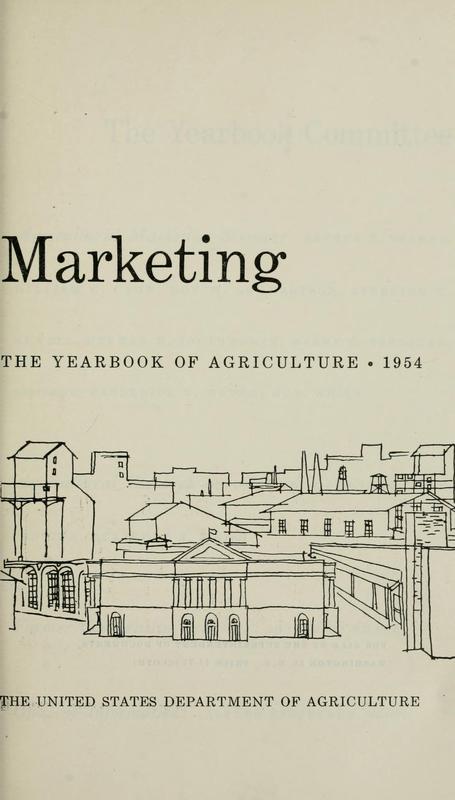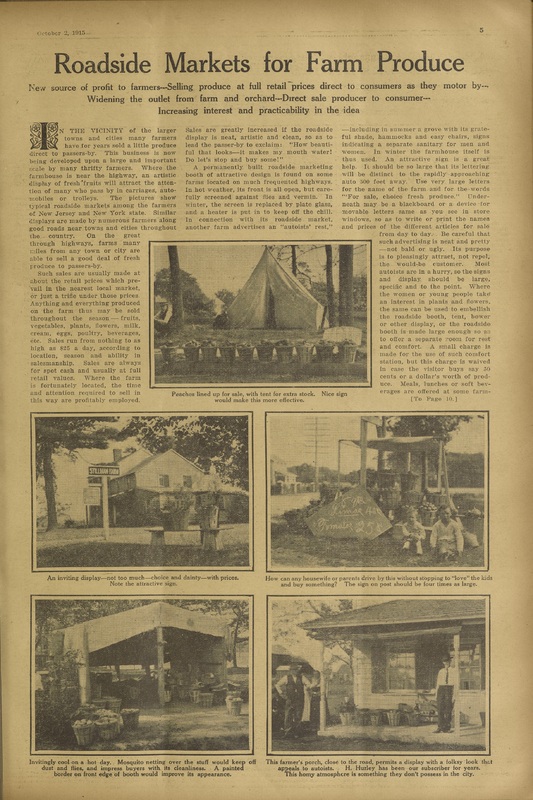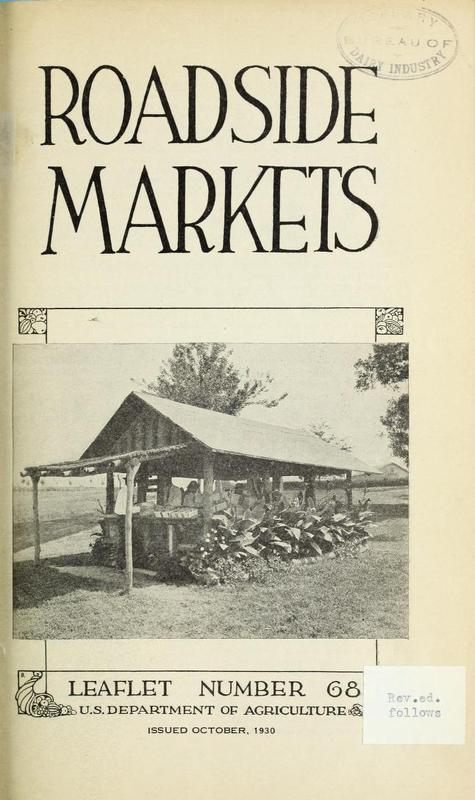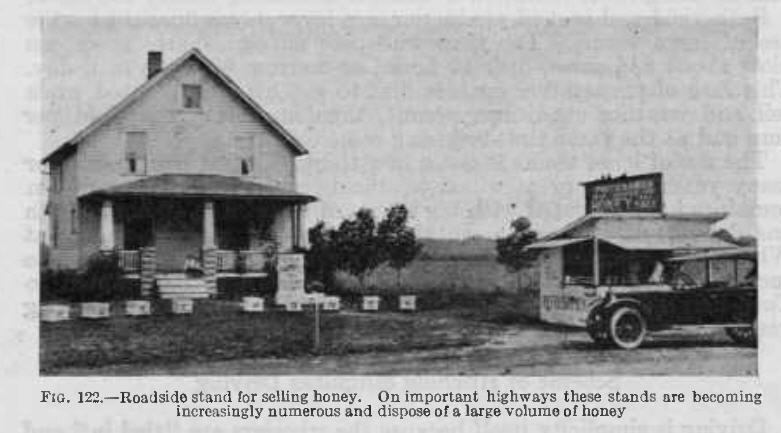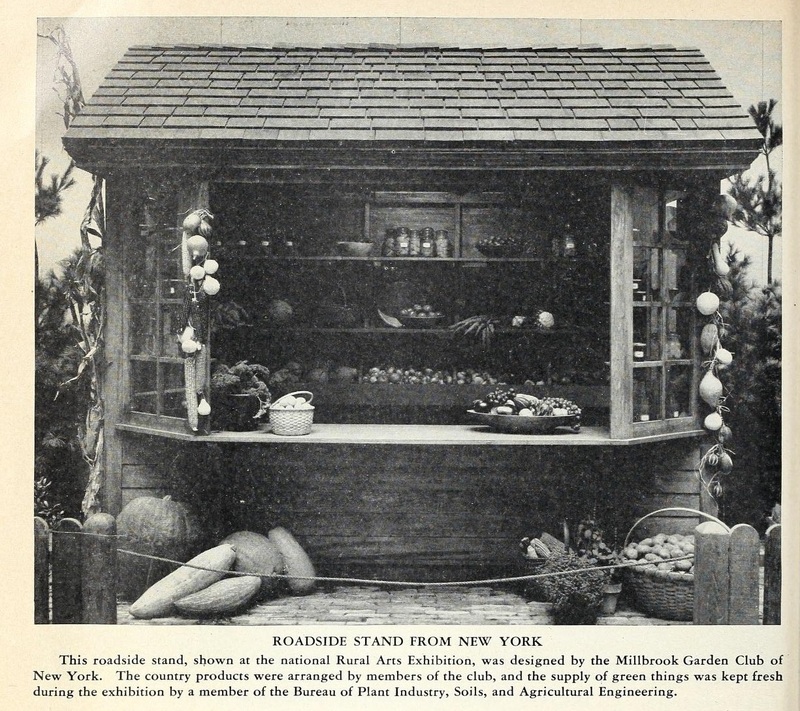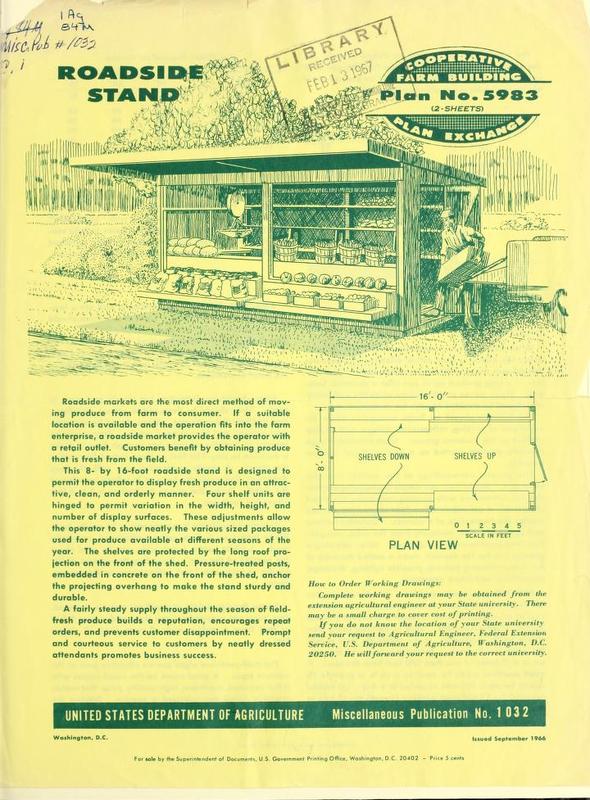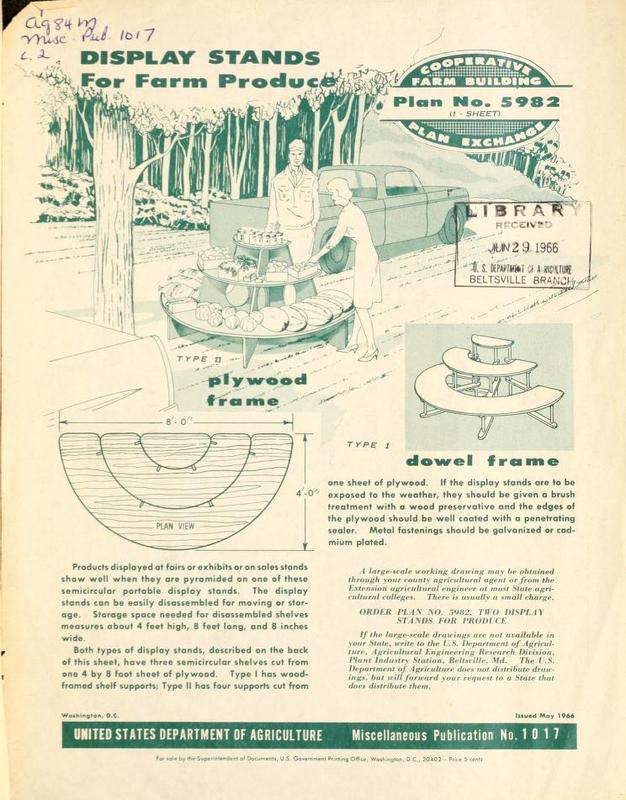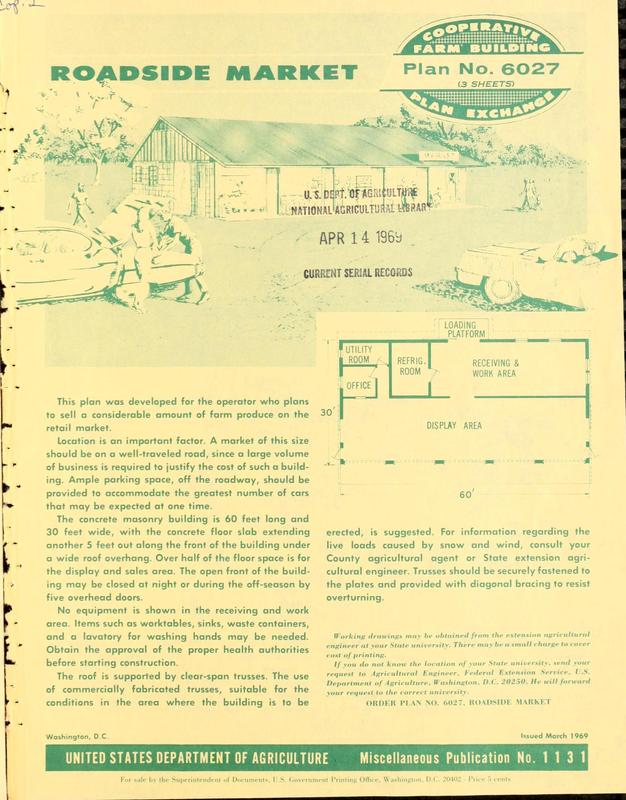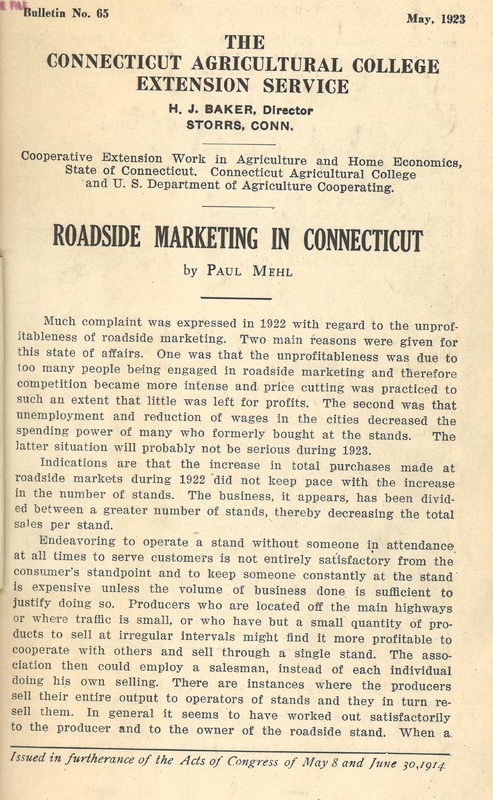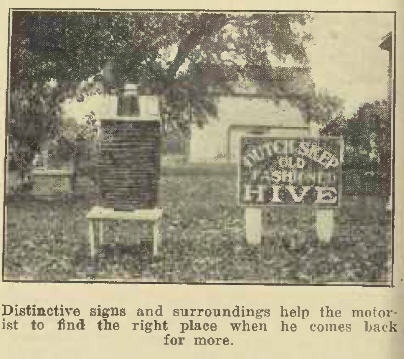Roadside Stands
A roadside stand may be just a table on the lawn, where surplus garden products can be displayed for sale from time to time. It may be a more permanent stand in front of the home or on a nearby highway, with a display counter or shelves, and a roof to protect the produce and the attendant from both sun and rain. It may still be more ambitious, a fairly large structure where several farm families cooperate to sell most of their fruit and vegetables and other products to steady customers and passing motorists who like to buy direct from the growers to get freshness and high quality.
A Roadside Stand. (1936). U.S. Department of Agriculture. Press Service Homemaker News. Number 43
Of the many direct-to-consumer marketing methods used by producers, roadside stands have stood the test of time, remaining relatively unchanged in their form and function.
-
Selling by the Roadside from Coast to Coast
Farmers As Their Own Salesman. (1955). Lomasney, W.F. and Bevan, L.A. Marketing: The Yearbook of Agriculture, 1954
“Of the many direct marketing practices that can be followed by farm families, the most practical seems to be the roadside stand located on or near the farm and operated on a regular schedule as one part of the farm enterprise.
A wide variation exists in the types of facilities, products, and services provided by farmers' roadside markets. Some are only a sign saying that one or more food items can be obtained at the farmhouse or other farm building. At the other extreme are stands that have many products.” p. 23
Roadside Markets for Farm Produce. (1915). The Orange Judd Farmer, 59(14), October 2, p. 5,10
“In the vicinity of the larger towns and cities many farmers have for years sold a little produce direct to passers-by. This business is now being developed upon a larger and important scale by many thrifty farmers. Where the farmhouse is near the highway, an artistic display of fresh fruits will attract the attention of many who pass by in carriages, automobiles or trolleys. The pictures show typical roadside markets among the farmers of New Jersey and New York state. Similar displays are made by numerous farmers along good roads near towns and cities throughout the country. On the great through highways, farms many miles from any town or city are able to sell a good deal of fresh produce to passers-by.” p. 5
Selling Over the Roadside Stand. (1922). Crabtree, Dora Cate. Better Fruit, p. 11
“The 'Locust Tree Stand' as it is known in the community was the first of its kind along the Oregon-Washington highway and for many years had practically the entire business. Other farmers seeing the advantage of such a method of selling have adopted the plan until this year nearly every other farm from Milton-Freewater north to the state line has its little fruit and vegetable stand. While the increase in the number of stands has cut down the amount of business for any one stand yet the increase in tourist travel from year to year and the increasing popularity with residents of the nearby towns of this method of buying still leaves a profitable business for all.”
Roadside Markets. (1930). Sherman, Caroline Baldwin. U.S. Department of Agriculture. Leaflet Number 68
“The officials in this State [Massachusetts] believe in making a distinction between products that have been raised near by and those that have been brought a considerable distance for sale. Officials in Ohio, on the other hand, find no disadvantage in the selling, at roadside markets, of products brought in hundreds or even thousands of miles, provided no deception is practiced. They think that this type of roadside market has just as much economic justification for its existence as though the products offered were grown by the marketer himself.” p. 6
“Hours of attendance at roadside markets are necessarily long, the work is particularly heavy on holidays and on Sundays, the task of gathering and preparing the products must usually be done very early in the morning, and attendance at the stand, hour after hour, is often monotonous. From the point of view of the farm family these considerations must be weighed when comparing the advantages of different methods of marketing; from the point of view of the customer they should be remembered when the prices are considered.” p. 4
Honey for Consumer Reaches Markets in Three Main Forms. (1928). Clay, H.J. Yearbook of Agriculture, 1927p. 381-383
“Roadside stands have become important in the sale of honey. Beekeepers on well-traveled roads often sell their entire crop of thousands of pounds of honey to passing automobilists and buy from other beekeepers to fill the demand. Attractive stands, with signs leading to them for at least half a mile, and high-quality honey, well packaged, will make the buyer remember where he bought.” (Figure 122 – Roadside stand for selling honey.) p. 383
-
Building and Display Plans
The Place of Handicrafts in Rural Life. (1946). Eaton, Allen. Rural Handicrafts in the United States. pp. 5-22
"Balancing the pottery cabinet at the opposite or east end of the gallery was an attractive roadside stand designed by members of the Millbrook Garden Club of New York State, who came to Washington to dress it up. The exhibits were kept fresh by daily replacement by one of the men in the Bureau of Plant Industry, Soils, and Agricultural Engineering. The roadside stand was unusually attractive in design and color. When artistically filled with fruits, flowers, eggs, grains, meats, jellies, jams, honey, beeswax, herbs, corn, peppers, and other farm products, it gave just the aesthetic rural note needed. Near the stand was placed an attractive farm-home pantry shown by the Texas Extension Service. A well-filled farm- home pantry with satisfying form and color balance, and with proper variety and food balance for the family's annual food supply, is often a work of art that lifts those who fill it to a higher plane of living and an appreciation of beauty in work well done." p. 11
Roadside Stand. (1966). U.S. Department of Agriculture. U.S. Department of Agriculture. Miscellaneous Publication Number 1032. Cooperative Farm Building Plan Exchange. Plan Number 5983
“Roadside markets are the most direct method of moving produce from farm to consumer. If a suitable location is available and the operation fits into the farm enterprise, a roadside market provides the operator with a retail outlet. Customers benefit by obtaining produce that is fresh from the field.” p. 1
Display Stands For Farm Produce. (1966). U.S. Department of Agriculture. U.S. Department of Agriculture. Miscellaneous Publication Number 1017. Cooperative Farm Building Plan Exchange. Plan Number 5982
“Products displayed at fairs or exhibits or on sales stands show well when they are pyramided on one of these semicircular portable display stands.” p. 1
Roadside Market. (1969). U.S. Department of Agriculture. U.S. Department of Agriculture. Miscellaneous Publication Number 1031. Cooperative Farm Building Plan Exchange. Plan Number 6027
“This plan was developed for the operator who plans to sell a considerable amount of farm produce on the retail market.
Location is an important factor. A market of this size should be on a well-traveled road, since a large volume of business is required to justify the cost of such a building. Ample parking space, off the roadway, should be provided to accommodate the greatest number of cars that may be expected at one time.” p. 1
-
Unique Signs Bring In Motorists
Roadside Marketing in Connecticut. (1969). Mehl, Paul The Connecticut Agricultural College Extension Service Bulletin Number 65
“The Importance of Signs.
The purpose of a sign may be either:
1. To designate the direction in which the stand is located, or to call attention of the driver to the fact that he is approaching one.
2. To attract the attention of the patrons to the name of the person or persons who own or operate the roadside market.
3. To announce the name, prices, grade, or quality of the products offered for sale. 4. To advertise brand names or trademarks.
Artistic signs appeal to the eye and often are remembered by those who see them. Each operator of a roadside market ought to have two kinds of signs. Along the highway at a distance of 500 feet in either direction a sign ought to be placed advising the passerby that he is approaching a roadside market and what special product is offered for sale. This notice will give the occupants of automobiles sufficient time to slow down and prepare to stop. Whenever it is necessary to leave the main highway in order to reach the stand, signs should be placed at frequent intervals designating the direction in which to travel. Signs should be large enough to be read at a distance and should not be so located as to be hidden from view because of curves in the road. They should preferably be durable and attractive and easily taken down when the stand is closed for the season so as not to lead people to believe that “fresh fruits or vegetables” are offered for sale when such is not the case. Signs ought only be put up when goods are actually to be had. In putting up signs one should be sure to see that he doesn’t violate the state laws regarding advertising on private property and public highways. The Connecticut laws regarding advertising on private property and highways is given in the Appendix.” p. 5-6
Selling Honey at Roadsides: How Tons of Honey Can Be Sold At Good Prices At Little Expense. (1921). Newcomb, Robinson. Gleanings in Bee Culture, Volume 49pp. 557-559
“Something distinctive about the sign and the lawn will not only aid in causing the motorist to stop, but will also be a big help in bringing them back again. It is much easier for him to remember your place if there is something distinctive about it; he is much more apt to think of your honey each time he sees your distinctive features than he would be were he to see merely your sign and your house; and it is much easier to direct others to you if you have something which distinguishes you from all others who have honey for sale. Two or three easily read words will differentiate one sign from another, and are enough to make one sign a sign to be remembered where another is forgotten. Too many words are to be avoided as the motorist can not read many easily, nor would he if he could. Such words as “Best Ever,” “Try It!” “No Sale Sunday” may be used. Each will want to choose his own. It is not a difficult matter to get something distinctive for the lawn. In most communities it is possible to get an old skep, such as pictured here, or some quaint hand-made hive of some sort.” p. 558
 An official website of the United States government.
An official website of the United States government.


